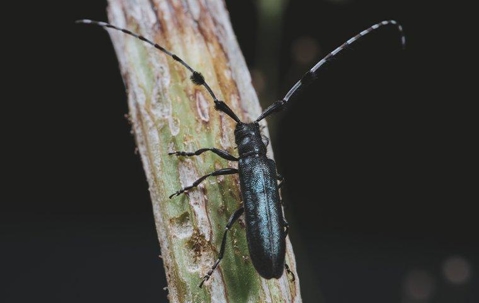Many insects and creatures have developed quite a reputation. Some are so well-known, they are at the forefront of pest control plans for Streator residents. For instance, rodents and roaches are a priority because they contaminate food and spread disease. Bees and wasps are near the top of control lists because they can issue painful and/or deadly stings. Other critters are either forgotten about or people aren’t aware they exist.
Long-horned beetles aren’t talked about much. Several home and business owners haven’t even heard of them. They might quietly creep the earth, but they can do major damage. Further, these bugs can take over your property without you knowing. Study up on them now so you can prevent them with an assist from Quik-Kill Pest Eliminators.
How Do Long-Horned Beetles Look & Behave? What Are The Risks?
Long-horned beetles are 3/8 to one inch long and have a very unique appearance. Their shiny black bodies are cylindrical and stretched out, with white spots. Their antennas are white and black, and about the length of their frames. The top of their legs are blueish-white. Larvae are cream-colored and can grow to be 1 ½ inches long.
These pests are a nightmare for people who pride themselves on having a healthy and beautiful lawn. Long-horned beetles live in and feed on trees, lumber, logs, unseasoned wood, and hardwood. Their favorites include:
- Horse chestnut
- Maple
- Ash
- Birch
- Willow
- Poplar
- Elm
After the beetles release their eggs deep in the wood and they hatch, the wormy larvae munch away until adulthood. When they exit the nest and fly off, it leaves a hole that’s 1/8 to 3/8 of an inch round. You’re most likely to spot these pits in the trunk or branches; there will be several of them. These critters are impactful with their pillaging. Trees they inhabit will lose vital nutrients, such as sap and water, and die.
Though long-horned beetles are primarily outdoor creatures, they could venture inside because they are nearby in the yard. Open doors and windows, and voids in foundations are their typical entry points. You might have an infestation if you see the adults fluttering about, and their exit holes in wood and bark. If a tree has leaves that appear saggy and/or discolored, that too suggests an infiltration.
How Can Long-Horned Beetles Be Prevented?
Believe it or not, there are a few positives about long-horned beetles. For one, they can’t bite or sting you. Two, they don’t bother cured wood that’s often used to erect furniture and buildings. Third, these bugs can help return nutrients to the soil when they focus on decaying trees. Despite all these relieving facets, you probably don’t want these pests around if you can avoid it. Here’s what you can do to stop them:
Keep wood and tree material distanced from your property.
Check firewood, logs, and unfinished wood before bringing it inside.
Burn firewood immediately.
Try not to plant trees long-horned beetles favor.
Check your property for gaps in foundations, windows, and doors. If you find any, have them sealed.
What Can Quik-Kill Pest Eliminators Do About Long-Horned Beetles?
At Quik-Kill Pest Eliminators, we have specialized treatments designed to exterminate wood-destroying critters, like long-horned beetles. All of our products and devices are eco-friendly. There’s no need to be concerned about your vegetation or trees getting accidentally ruined by our processes. Our team is QualityPro certified; they know how to work with great care.
We’ve offered residents affordable plans and high quality servicing for over 90 years. You could be next. A free inspection awaits when you call today!

